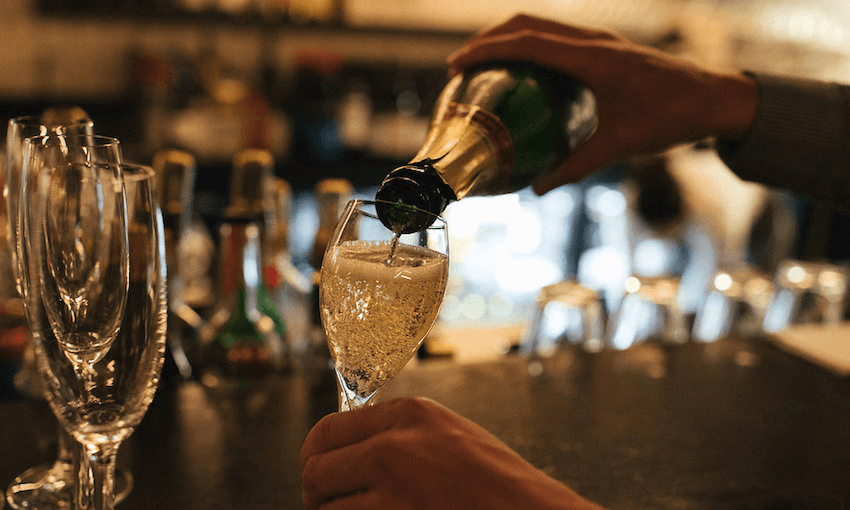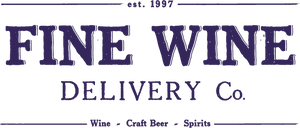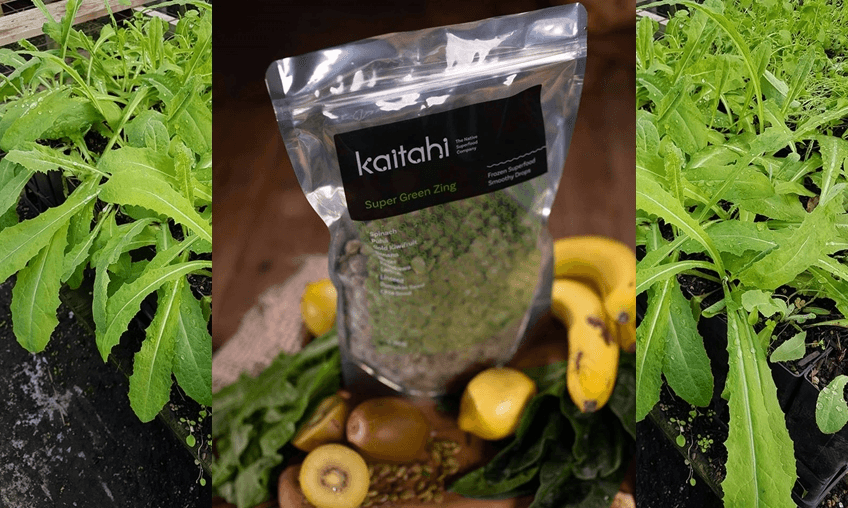‘Too much of anything is bad, but too much champagne is just right,’ according to Mark Twain. Simon Day has a cleansing glass of bubbles (or three) to go with a history lesson on champagne.
Champagne and fried chicken make surprisingly good tablemates. The sharp, cleansing effervescence of the wine cuts through the rich fattiness of the deep-fried poultry. They’re both celebratory kinds of food and drink. And at a recent event, matching fried chicken with expensive bubbles was a fast way to make one of the most prestigious drinks feel more approachable – a perfect icebreaker to a discussion about champagne that promised to be “not serious”.
A winemaker, a wine seller, a wine pourer and a wine server had been convened to demystify champagne and explain if, and how, our sparkling stands up to the French finesse in the first New Zealand edition of Not Serious Wine Chats. The champagne glistened in flutes, and my fingers glistened with grease, as we learned about what makes sparkling wine so magic. Hidden from a cold winter’s night in the warmth of Culprit’s dining room above Wyndham St in central Auckland, with a blanket of chicken and sparkling wine, we learned about the special relationships the four speakers had with champagne.
The wine seller
“It’s a celebration wine, a vehicle of happiness. Drinking a bottle of champagne at seven o’clock in the morning takes you to places red wine would not take you,” says Jean-Christophe Poizat, co-founder of French fine-wine merchant Maison Vauron.
Poizat is gorgeously French. He is handsome and charming. And despite living in New Zealand for nearly 20 years, his accent is still thick and heavy. His family have been in the wine-selling game since 1879. Poizat opened his boutique retailer in 1999 to celebrate French wine and its stories in New Zealand. And on the night he starts with a good yarn about champagne.
He tells the story of two people more responsible than anyone else for the product and prestige champagne carries today. Dom Pierre Pérignon was a French Benedictine monk who lived his life in poverty, and was essential to the development of the region’s wine. He was a pioneering winemaker and although bubbles were seen as a flaw in his time, he developed ways to reduce their presence and give champagne its more delicate sparkling nature. He was one of the first to blend grape varietals to mask imperfections, and he progressed the secondary bottle fermentation towards its modern, delicate art. His name is now carried on the bottle of champagne house Moët & Chandon’s premier sparkling product.
King Louis XIV drank almost nothing but champagne. And when he declared it the best wine in the country, the huge growth in demand from the Sun King’s endorsement began the rise of the region’s reputation (and a long-running feud with Burgundy).
Both men were born in 1638, both died in September 1715.
Poizat loves this history of champagne, and it’s this narrative that he believes justifies its prestige and price. It’s this story that is the final piece in the region’s famous “terroir”, the almost spiritual concept that refers to a wine region’s vibe through its representation of place.
“It’s the soil. It’s the topography, the climate, the exposure to the sun, the people. It’s a combination of things that makes the terroir unique and very different to any other region in the world. It’s very hard to pin them down,” he says.
The wine server
“It’s something decadent. That’s why you have it at lunch,” says Rebecca Smidt, who owns and runs game and wild-food restaurant Cazador on Auckland’s Dominion Rd with her husband Dariush Lolaiy.
People will always order sparkling wine for special occasions. Champagne’s prestige once meant it was held superior over all else, but things are changing and New Zealand’s bubbles are starting to stand up to the traditions of France.
Smidt, who is charge of front of house while Lolaiy runs the kitchen, says most of Cazador’s customers order wine based on their recognition of their favourite grape variety. Pinot noir lovers stick to pinot, chardonnay drinkers order chardonnay. Yet few people actually know what grapes are used to make champagne. (The grapes you’re allowed to use to make champagne are pinot noir, pinot meunier and chardonnay.)
“It’s so much about the occasion. And the enormous amount of marketing behind a wine that is made in a completely different way,” says Smidt.
Yet despite the huge reputation of champagne, the rise of local sparkling means it’s no longer the only option when you want to celebrate.
“We sell a lot of New Zealand méthode, because it is familiar and it is a beautiful product,” says Smidt.
“We are starting to find provenance will supersede prestige. They want to know about the maker, they want to know about the process, they want to know about the region, and they want to know about the ethics.”
And this is where the restaurants, and waiters especially, are important guides for the consumer.
The wine pourer
Food and beverage fashions make it to New Zealand slowly. They start in London and New York, filter through Melbourne and Sydney, before eventually reaching Auckland and Wellington. Ismo “Mo” Koski came to Auckland via Sydney, and before opening his own restaurant Apero on Karangahape Rd in 2014, he worked the tables in some of the city’s best restaurants (The Grove, Sidart, Merediths). He’s watched sparkling trends work their way to our end of the world. Prosecco went big early in the decade in London, and now it’s here serving its unique role.
Prosecco is fun. It’s Sunday afternoon in the sun. It’s an Aperol spritz on the terrace.
“Prosecco is more relaxed. A glass of fizz,” says Koski.
Ever the patriot, Poizat quickly interrupts this celebration of the joys of prosecco and asks: “But Mo… what would you open if you were trying to seduce someone?”
Koski knows there’s only one answer. “It’s got to be champagne.” Specifically, the Nathalie Falmet Champagne Rosé.
We taste one of his favourites on his wine list, Champagne Collet. It’s dry, crisp, sweet like caramelised citrus, fun and exciting. Champagne Collet was established in 1921 but only arrived in Aotearoa in 2014 when it was listed at Apero. The collective, champagne Collet, is now owned by the growers – almost 500 of them. They save a small parcel of the grapes they grow for other top Champagne houses and pop it in Collet so they have their own wine to enjoy, knowing it is they who produced it.
Koski is an advocate for the work of the lesser-known names of champagne. He loves “growers’ champagne”, which is like the craft beer of bubbles, where small houses grow grapes and then produce wine from their own crops (the big names blend juices from around the region).
“We’ve got people buying Veuve Clicquot because 25 years ago they drank it at their wedding. Fuck, get over it! New Zealanders need to get out of their square and try something new,” he says.
He wants us to try local pet-nat wines too. Short for pétillant-naturel, AKA méthode ancestrale, it’s an ancient approach to making bubbles that’s witnessing a modern revival. The wine is bottled before the first fermentation is complete and there’s no addition of sugar to create a second fermentation, resulting in a lightly sparkling, sometimes cloudy wine, which is capped rather than corked. They’re exciting, and varied, and sometimes a bit of a lottery (and the next Not Serious Wine Chats is on natural wines in October).
And not everyone loves them.
The winemaker
“They’re just too lazy to get rid of the lees,” says Clare Allan, half sarcastically, half seriously, of pet-nat creators.
When she explains the arduous process of replicating champagne in New Zealand using méthode traditionnelle, you can understand why she thinks the trend is in fact an endorsement of short cuts.
As we drink the golden 2011 blanc de blancs from her Huia Vineyard in Marlborough, Allan outlines the winemaking technique for their sparkling. It’s a long and laborious process. You pick the grapes and hand press them. Then you ferment that juice in barrel. After 12 months, that base wine goes into a bottle with a bit of sugar and yeast, and that produces the second ferment inside the vessel, producing the bubbles. It must sit with that yeast for at least 18 months to be considered a vintage. There’s a lot of pressure, the same pressure as a truck tyre, and that’s why sparkling bottles are so thick and heavy.
Huia’s sparkling stays there for five years. Then it’s hand riddled by Allan’s husband Mike (who worked at Veuve Clicquot), rotating the bottles in small turns he moves the racked bottles from horizontal to “sur pointe” where the bottles are neck down, drawing the sediment into the top and the wine left crystal clear.
Then they’re ready for disgorgement. The neck, where all the yeast is left, is frozen and the temporary cap is popped off, and the pressure pushes the yeast plug out. It’s then topped up with clean disgorged wine and a little residual sugar called the dosage, and then they’re corked. The bottles are given a gentle shake so the sugar rolls through it, they’re washed, and finally “dressed” (sparkling wine is not “labelled”).
It’s a five-year process, and a real labour of love.
“We don’t rely on our sparkling wine to survive. We would love to make lots of sparkling but to be here next year we don’t. To price our sparkling wine at a survivable price it would be $67 to $85 retail,” says Allan. It actually retails for $37 to $42.
“Part of being sustainable is you need to stay in business,” says Allan.
Why bother making sparkling wine in New Zealand then, if it’s so uneconomic?
“Living in France, we developed a taste for Krug. Working in Champagne, I didn’t eat very much at all except for the odd chocolate eclair from the local bakery, and we just drank as much wine as we could. We realised that we were going to keep our palates and taste buds in the style they had become accustomed to we were going to have to make some sparkling wine,” she says.
“All you can do is try and make a wine that is as good as champagne.”
The Spinoff’s beverage content is brought to you by Fine Wine Delivery Co, which is completely and utterly devoted to good taste, whether it’s wine, food, craft beer, whisky, rum… Check out their website or pop into one of the two Auckland superstores.






